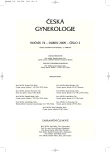Analyses of LOH and expression in healthy gland, DCIS and invasive breast cancer gland
Authors:
Michal Zikán 1
; D. Pavlišta 1
; Z. Velenská 2; D. Cibula 1
Authors‘ workplace:
Onkogynekologické centrum, Gynekologicko-porodnická klinika 1. LF UK a VFN, Praha, přednosta prof. MUDr. A. Martan, DrSc.
1; Ústav patologie 1. LF UK a VFN, Praha, přednosta prof. MUDr. C. Povýšil, DrSc.
2
Published in:
Ceska Gynekol 2009; 74(2): 102-105
Category:
Original Article
Overview
Objective:
To characterize molecular pattern differences (LOH and expression) between DCIS and invasive breast cancer.
Design:
Original paper.
Setting:
Oncogynecologic center, Clinic of Obstetrics and gynecology, First Faculty of Medicine, Charles University in Prague and General Teaching Hospital, Prague.
Material and methods:
We analyzed LOH in 3 genes (BRCA1, BRCA2 and p53) and expression of 2 genes (VEGF and Bcl-2) in fresh frozen tissue samples of DCIS and invasive breast cancer. Each sample was evaluated by pathologist before sampling and analysis.
Results:
Molecular pattern analysis was performed in three types of tissue: healthy breast gland (65 samples), DCIS (25 samples) and invasive breast cancer (42 samples). LOH in BRCA1 was detected in 22.3% of invasive cancer samples and in 13.4% of DCIS; BRCA2 LOH in 32.1% of invasive cancer samples and in 14.1% of DCIS; p53 LOH in 35.6% of invasive cancer samples and in 33.2% of DCIS. VEGF was overexpressed in 15.3% of invasive cancer samples and in 8.3% of DCIS. Overexpression of Bcl-2 was detected in 13.2% of invasive breast cancer samples and in 7.1% of DCIS.
Conclusion:
We confirmed that substantial part of DCIS has molecular pattern similar to invasive cancer. These molecular changes could serve as potential markers of DCIS progression to invasive cancer or they could identify subgroup of DCIS with latent invasion.
Key words:
breast cancer, DCIS, LCIS, p53, BRCA1, BRCA2, Bcl-2, VEGF.
Sources
1. Abdel-Fatah, TM., Powe, DG., Hodi, Z., et al. Morphologic and molecular evolutionary pathways of low nuclear grade invasive breast cancers and their putative precursor lesions: further evidence to support the concept of low nuclear grade breast neoplasia family. Am J Surg Pathol, 2008, 32, 4, p. 513-523.
2. Allred, DC., Wu, Y., Mao, S., et al. Ductal carcinoma in situ and the emergence of diversity during breast cancer evolution. Clin Cancer Res, 2008, 15, 14, 2, p. 370-378.
3. Farabegoli, F., Champeme, MH., Bieche, I., et al. Genetic pathways in the evolution of breast ductal carcinoma in situ. J Pathol, 2002, 196, p. 280-286.
4. Hieken, TJ., Farolan, M., D’Alessandro, S., et al. Predicting the biologic behavior of ductal carcinoma in situ: an analysis of molecular markers. Surgery, 2001, 130, p. 593-600.
5. Hieken, TJ., Cheregi, J., Farolan, M., et al. Predicting relapse in ductal carcinoma in situ patients: an analysis of biologic markers with long-term follow-up. Am J Surg, 2007, 194, 4, p. 504-506.
6. Hu, M., Yao, J., Carroll, DK., et al. Regulation of in situ to invasive breast carcinoma transition. Cancer Cell, 2008, 13, 5, p. 394-406.
7. Kataoka, N., Cai, Q., Wen, W., et al. Population-based case-control study of VEGF gene polymorphisms and breast cancer risk among Chinese women. Cancer Epidemiol Biomarkers Prev, 2006, 15, p. 1148-1152.
8. Leong, AS., Sormunen, RT., Vinyuvat, S., et al. Biologic markers in ductal carcinoma in situ and concurrent infiltrating carcinoma. A comparison of eight contemporary grading systems. Am J Clin Pathol, 2001, 115, p. 709-718.
9. Reis-Filho, JS., Lakhani, SR. The diagnosis and management of pre-invasive breast disease: genetic alterations in pre-invasive lesions. Breast Cancer Res, 2003, 5, p. 313-319.
10. Sakorafas, GH., Farley, DR., Peros, G. Recent advances and current controversies in the management of DCIS of the breast. Cancer Treat Rev, 2008, 34, 6, p. 483-497.
11. Shekhar, MP., Tait, L., Pauley, RJ., et al. Comedo-ductal carcinoma in situ: A paradoxical role for programmed cell death. Cancer Biol Ther, 2008, 12, 7, p. 11.
12. Smith, KL., Adank, M., Kauff, N., et al. BRCA mutations in women with ductal carcinoma in situ. Clin Cancer Res, 2007, 13, 14, p. 4306-4310.
13. Viacava, P., Naccarato, AG., Bocci, G., et al. Angiogenesis and VEGF expression in pre-invasive lesions of the human breast. J Pathol, 2004, 204, p. 140-146.
14. Vogl, G., Dietze, O., Hauser-Kronberger, C. Angiogenic potential of ductal carcinoma in situ (DCIS) of human breast. Histopathology, 2005, 47, p. 617-624.
15. Zagouri, F., Sergentanis, TN., Zografos, GC. Precursors and preinvasive lesions of the breast: the role of molecular prognostic markers in the diagnostic and therapeutic dilemma. World J Surg Oncol, 2007, 31, 5, p. 57.
Labels
Paediatric gynaecology Gynaecology and obstetrics Reproduction medicineArticle was published in
Czech Gynaecology

2009 Issue 2
Most read in this issue
- Sexual Functions after Laparoscopically Assisted Vaginal Hysterectomy (LAVH) and Total Laparoscopic Hysterectomy (TLH) in preoperatively asymptomatic women
- Thermachoice thermal baloon therapy – a 10-year-experience
- Fitz-Hugh-Curtis syndrome: a case report
- Ovarian remnant syndrome
